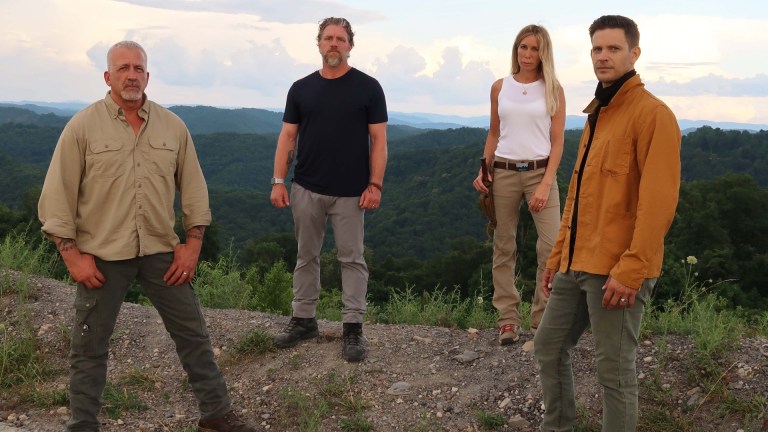Dr. Jane Goodall Answers Some Big Expedition Bigfoot Questions
The cast of Expedition Bigfoot tells Talking Strange why the famed primatologist adds validity to the Sasquatch search

On March 20, the Expedition Bigfoot team kicked off its third season on Travel Channel and discovery+ with a two-hour premiere that included a “pre-show” featuring an interview with famed primatologist Dr. Jane Goodall. Then the team — primatologist Dr. Mireya Mayor, host Bryce Johnson, survivalist Russell Acord, and author Ronny Le Blanc — returned to Washington State’s Olympic Peninsula after destructive wildfires last year forced them to abandon their investigation.
Utilizing a combination of equipment and overnight explorations, the team approaches their search for Sasquatch with an open-minded skepticism. For the premiere, they implement an agriculture drone to spray primate pheromones in hopes of drawing out the creature they seek. Additionally, LeBlanc and Mayor appear to notice a figure peering down at them from a ridge while they’re on the river, and Acord’s shelter is accosted by something outside while hunkered down for the night.
To chat about the new season, the cast of Expedition Bigfoot joined the Talking Strange paranormal pop culture podcast and video interview show — which is embedded to view below, and available on Spotify and Apple Podcasts.
The conversation with Goodall is a highlight of the Expedition Bigfoot premiere. Mayor — who co-discovered the world’s smallest primate, a mouse lemur classified as Microcebus mittermeieri — is a longtime associate of hers, and the two openly discuss the possibility of Sasquatch’s existence. She said Goodall has always had an open mind, and is not afraid of going against mainstream science, so she does not dismiss that the animal might be out there, and points to the fact that nearly every culture has a version of “Bigfoot.”
Mayor noted that Goodall also provided a potential answer to a popular skeptic question about Sasquatch: Where are the bodies?
“That was one of the big questions I had going into all of this,” said Mayor. “Her response is that it is very possible this is a species far more intelligent than we possibly imagined, and they are burying their bodies in a way we cannot find.”
Mayor added, “the truth is, with that response, there is this tendency with us humans to position ourselves at the top of the food chain, the hierarchy of intelligence in the animal kingdom, but we know enough now to know that is not the case, and there could be creatures far more intelligent, far more sophisticated, far more adapted to living life in the woods that we are not privy to.”
Le Blanc said the inclusion of Goodall “swings that door wide open” for the Bigfoot community and felt like validation for the show.
“To have a giant like Jane Goodall even entertain the idea to be a part of it, and what she reveals gets you pumped in the sense you feel you’re on the right path and have someone saying continue to do what you’re doing. And I think it opens the door to a wider audience of people to drive awareness to what we’re trying to do, and the reality is out there we’re trying to bring forth.”
“Jane Goodall does for Bigfoot what our military fighter pilots do for the UFO phenomenon,” said Johnson. “They take away some of this taboo nature that surrounds the subject. When people see someone like Jane Goodall speaking on the subject matter of Bigfoot, it becomes a little less silly, and a little more serious.”
With regards to the Washington State location, Johnson said it was important for them to pick up there for the new season.
“Everybody wanted us to go back to Washington because we were picking up so much activity, in and around the lake where Russell found that footprint” he said, talking about the team’s return to the area after a year away. “To have to leave early was devastating, but we knew this was the place we had to come back to.”
Acord added that the fires, though destructive, surprisingly added some benefit to their search.
“It basically gives you a timeline, so all the undergrowth is gone, all the trees have been scarred and marked,” he said. “There’s a lot less coverage to hide. You’re pretty much pushing animals into areas with a lot more rock formations, a lot heavier terrain to navigate around. You’re pushing them out of open spaces into more clustered areas. It’s actually pretty decent for research.”
Mayor said the fires also make it more challenging for research because they are seeking shelter and food.
“I worked in areas in Madagascar that are constantly being devastated by fires, and have seen animals with singed heads running away, trying to escape these areas. It takes a long time to repopulate depending on just how much devastation … Animals need those three things: food, water, and shelter, and fire has the potential to take away at least two of those.”
Expedition Bigfoot returns with new episodes on Sundays, on discovery+ and 10 p.m. on Travel Channel. For more from the cast, check out the Talking Strange interview on YouTube, Spotify, and Apple Podcasts. And don’t miss new episodes of Talking Strange every Tuesday.
